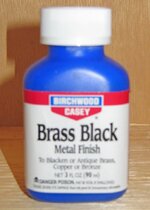For virtually all acrylic blanks I paint both the tube and reverse paint the blank. I use spray paint in a wide variety of colors, depending on what I want the finished blank to look like. You would be amazed how different color paints dramatically change the color/look of a finished blank. To paint the tubes, I slip the tubes onto a cheap four prong grill fork and spray them the color I want. Then I slip the painted tubes onto finish nails I have nailed into a strip of wood to let them dry at least 24 hours. To reverse paint the blank, I clamp the drilled blank into a hand-help spring clamp, the kind you can buy at any big box store or hardware store for a couple of bucks. Then, I hold the clamped blank over an open trash can and give it a few spritzes from each end. The clamp holds the blank secure and keeps my hand away from the spray paint so there's no mess to clean up. The total time required to paint both the tube and the blank is about a minute. I use good quality spray paint (i.e. Rustoleum) as it gives better coverage and a smooth thin coat. Just one man's way to get the job done...
Jim Smith

